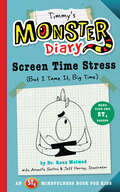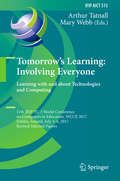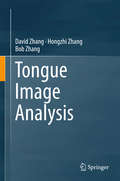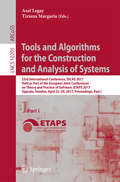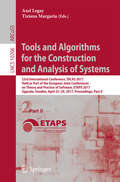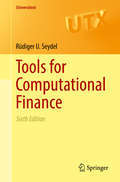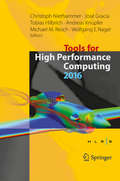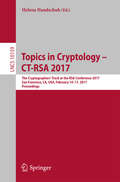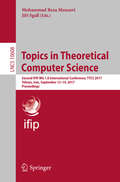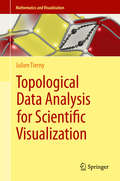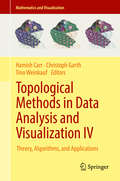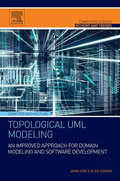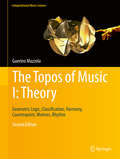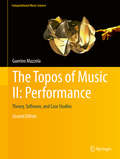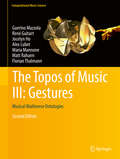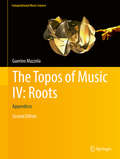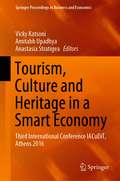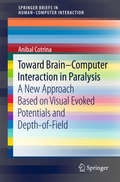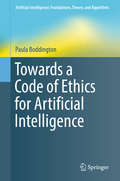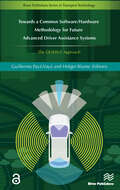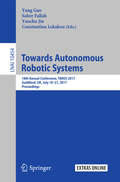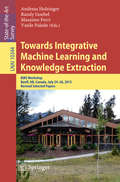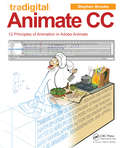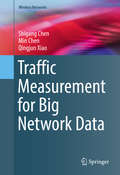- Table View
- List View
Timmy's Monster Diary: Screen Time Stress (But I Tame It, Big Time) (Monster Diaries #2)
by Raun Melmed Annette SextonUsing the "Time-Telling" and "ST4" techniques developed by Dr. Raun Melmed of the Melmed Center in Arizona, Timmy's Monster Diary teaches kids how to self-moniter the amount of time they spend on technology.
Tomorrow's Learning: 11th IFIP TC 3 World Conference on Computers in Education, WCCE 2017, Dublin, Ireland, July 3-6, 2017, Revised Selected Papers (IFIP Advances in Information and Communication Technology #515)
by Arthur Tatnall Mary WebbThis book constitutes the refereed post-conference proceedings of the 11th IFIP TC 3 World Conference on Computers in Education, WCCE 2017, held in Dublin, Ireland, in July 2017.The 57 revised full papers and 10 short papers were carefully reviewed and selected from 116 submissions during two rounds of reviewing and improvement. The papers are organized in the following topical sections: futures of technology for learning and education; innovative practices with learning technologies; and computer science education and its future focus and development. Also included is "The Dublin Declaration" which identifies key aspects of innovation, development successes, concerns and interests in relation to ICT and education.
Tongue Image Analysis
by David Zhang Hongzhi Zhang Bob ZhangThis is the first book offering a systematic description of tongue image analysis and processing technologies and their typical applications in computerized tongue diagnostic (CTD) systems. It features the most current research findings in all aspects of tongue image acquisition, preprocessing, classification, and diagnostic support methodologies, from theoretical and algorithmic problems to prototype design and development of CTD systems. The book begins with a very in-depth description of CTD on a need-to-know basis which includes an overview of CTD systems and traditional Chinese medicine (TCM) in order to provide the information on the context and background of tongue image analysis. The core part then introduces algorithms as well as their implementation methods, at a know-how level, including image segmentation methods, chromatic correction, and classification of tongue images. Some clinical applications based on these methods are presented for the show-how purpose in the CTD research field. Case studies highlight different techniques that have been adopted to assist the visual inspection of appendicitis, diabetes, and other common diseases. Experimental results under different challenging clinical circumstances have demonstrated the superior performance of these techniques. In this book, the principles of tongue image analysis are illustrated with plentiful graphs, tables, and practical experiments to provide insights into some of the problems. In this way, readers can easily find a quick and systematic way through the complicated theories and they can later even extend their studies to special topics of interest. This book will be of benefit to researchers, professionals, and graduate students working in the field of computer vision, pattern recognition, clinical practice, and TCM, as well as those involved in interdisciplinary research.
Tools and Algorithms for the Construction and Analysis of Systems: 23rd International Conference, TACAS 2017, Held as Part of the European Joint Conferences on Theory and Practice of Software, ETAPS 2017, Uppsala, Sweden, April 22-29, 2017, Proceedings, Part I (Lecture Notes in Computer Science #10205)
by Axel Legay Tiziana MargariaThe two-book set LNCS 10205 + 10206 constitutes the proceedings of the 23rd International Conference on Tools and Algorithms for the Construction and Analysis of Systems, TACAS 2017, which took place in Uppsala, Sweden in April 2017, held as Part of the European Joint Conferences on Theory and Practice of Software, ETAPS 2017.The 48 full papers, 4 tool demonstration papers, and 12 software competition papers presented in these volumes were carefully reviewed and selected from 181 submissions to TACAS and 32 submissions to the software competition. They were organized in topical sections named: verification techniques; learning; synthesis; automata; concurrency and bisimulation; hybrid systems; security; run-time verification and logic; quantitative systems; SAT and SMT; and SV COMP.
Tools and Algorithms for the Construction and Analysis of Systems: 23rd International Conference, TACAS 2017, Held as Part of the European Joint Conferences on Theory and Practice of Software, ETAPS 2017, Uppsala, Sweden, April 22-29, 2017, Proceedings, Part II (Lecture Notes in Computer Science #10206)
by Axel Legay Tiziana MargariaThe two-book set LNCS 10205 + 10206 constitutes the proceedings of the 23rd International Conference on Tools and Algorithms for the Construction and Analysis of Systems, TACAS 2017, which took place in Uppsala, Sweden in April 2017, held as Part of the European Joint Conferences on Theory and Practice of Software, ETAPS 2017.The 48 full papers, 4 tool demonstration papers, and 12 software competition papers presented in these volumes were carefully reviewed and selected from 181 submissions to TACAS and 32 submissions to the software competition. They were organized in topical sections named: verification techniques; learning; synthesis; automata; concurrency and bisimulation; hybrid systems; security; run-time verification and logic; quantitative systems; SAT and SMT; and SV COMP.
Tools for Computational Finance (Universitext)
by Rüdiger U. SeydelComputational and numerical methods are used in a number of ways across the field of finance. It is the aim of this book to explain how such methods work in financial engineering. By concentrating on the field of option pricing, a core task of financial engineering and risk analysis, this book explores a wide range of computational tools in a coherent and focused manner and will be of use to anyone working in computational finance. Starting with an introductory chapter that presents the financial and stochastic background, the book goes on to detail computational methods using both stochastic and deterministic approaches.Now in its sixth edition, Tools for Computational Finance has been significantly revised and contains: Several new parts such as a section on extended applications of tree methods, including multidimensional trees, trinomial trees, and the handling of dividends;Additional material in the field of generating normal variates with acceptance-rejection methods, and on Monte Carlo methods;115 exercises, and more than 100 figures, many in color.Written from the perspective of an applied mathematician, all methods are introduced for immediate and straightforward application. A ‘learning by calculating’ approach is adopted throughout this book, enabling readers to explore several areas of the financial world.Interdisciplinary in nature, this book will appeal to advanced undergraduate and graduate students in mathematics, engineering, and other scientific disciplines as well as professionals in financial engineering.
Tools for High Performance Computing 2016: Proceedings of the 10th International Workshop on Parallel Tools for High Performance Computing, October 2016, Stuttgart, Germany
by Christoph Niethammer José Gracia Tobias Hilbrich Andreas Knüpfer Michael M. Resch Wolfgang E. NagelThis book presents the proceedings of the 10th International Parallel Tools Workshop, held October 4-5, 2016 in Stuttgart, Germany – a forum to discuss the latest advances in parallel tools.High-performance computing plays an increasingly important role for numerical simulation and modelling in academic and industrial research. At the same time, using large-scale parallel systems efficiently is becoming more difficult. A number of tools addressing parallel program development and analysis have emerged from the high-performance computing community over the last decade, and what may have started as collection of small helper script has now matured to production-grade frameworks. Powerful user interfaces and an extensive body of documentation allow easy usage by non-specialists.
Topics in Cryptology – CT-RSA 2017: The Cryptographers’ Track at the RSA Conference 2017, San Francisco, CA, USA, February 14–17, 2017, Proceedings (Lecture Notes in Computer Science #10159)
by Helena HandschuhThis book constitutes the refereed proceedings of the Cryptographer's Track at the RSA Conference 2017, CT-RSA 2017, held in San Francisco, CA, USA, in February 2017.The 25 papers presented in this volume were carefully reviewed and selected from 77 submissions.CT-RSA has become a major publication venue in cryptography. It covers a wide variety of topics from public-key to symmetric key cryptography and from cryptographic protocols to primitives and their implementation security. This year selected topics such as cryptocurrencies and white-box cryptography were added to the call for papers.
Topics in Theoretical Computer Science: Second IFIP WG 1.8 International Conference, TTCS 2017, Tehran, Iran, September 12-14, 2017, Proceedings (Lecture Notes in Computer Science #10608)
by Mohammad Reza Mousavi Jiří SgallThis book constitutes the refereed proceedings of the Second IFIP WG 1.8 International Conference on Topics in Theoretical Computer Science, TTCS 2017, held in Tehran, Iran, in September 2017. The 8 papers presented in this volume were carefully reviewed and selected from 20 submissions. They were organized in topical sections named: algorithms and complexity; and logic, semantics, and programming theory.
Topological Data Analysis for Scientific Visualization (Mathematics and Visualization)
by Julien TiernyCombining theoretical and practical aspects of topology, this book provides a comprehensive and self-contained introduction to topological methods for the analysis and visualization of scientific data.Theoretical concepts are presented in a painstaking but intuitive manner, with numerous high-quality color illustrations. Key algorithms for the computation and simplification of topological data representations are described in detail, and their application is carefully demonstrated in a chapter dedicated to concrete use cases.With its fine balance between theory and practice, "Topological Data Analysis for Scientific Visualization" constitutes an appealing introduction to the increasingly important topic of topological data analysis for lecturers, students and researchers.
Topological Methods in Data Analysis and Visualization IV: Theory, Algorithms, and Applications (Mathematics and Visualization)
by Hamish Carr Christoph Garth Tino WeinkaufThis book presents contributions on topics ranging from novel applications of topological analysis for particular problems, through studies of the effectiveness of modern topological methods, algorithmic improvements on existing methods, and parallel computation of topological structures, all the way to mathematical topologies not previously applied to data analysis. Topological methods are broadly recognized as valuable tools for analyzing the ever-increasing flood of data generated by simulation or acquisition. This is particularly the case in scientific visualization, where the data sets have long since surpassed the ability of the human mind to absorb every single byte of data. The biannual TopoInVis workshop has supported researchers in this area for a decade, and continues to serve as a vital forum for the presentation and discussion of novel results in applications in the area, creating a platform to disseminate knowledge about such implementations throughout and beyond the community. The present volume, resulting from the 2015 TopoInVis workshop held in Annweiler, Germany, will appeal to researchers in the fields of scientific visualization and mathematics, domain scientists with an interest in advanced visualization methods, and developers of visualization software systems.
Topological UML Modeling: An Improved Approach for Domain Modeling and Software Development (Computer Science Reviews and Trends)
by Janis Osis Uldis DoninsTopological UML Modeling: An Improved Approach for Domain Modeling and Software Development presents a specification for Topological UML® that combines the formalism of the Topological Functioning Model (TFM) mathematical topology with a specified software analysis and design method. The analysis of problem domain and design of desired solutions within software development processes has a major impact on the achieved result – developed software. While there are many tools and different techniques to create detailed specifications of the solution, the proper analysis of problem domain functioning is ignored or covered insufficiently. The design of object-oriented software has been led for many years by the Unified Modeling Language (UML®), an approved industry standard modeling notation for visualizing, specifying, constructing, and documenting the artifacts of a software-intensive system, and this comprehensive book shines new light on the many advances in the field.Presents an approach to formally define, analyze, and verify functionality of existing processes and desired processes to track incomplete or incorrect functional requirements Describes the path from functional and nonfunctional requirements specification to software design with step-by-step creation and transformation of diagrams and models with very early capturing of security requirements for software systems.Defines all modeling constructs as extensions to UML®, thus creating a new UML® profile which can be implemented in existing UML® modeling tools and toolsets
The Topos of Music I: Geometric Logic, Classification, Harmony, Counterpoint, Motives, Rhythm (Computational Music Science)
by Guerino MazzolaThis is the first volume of the second edition of the now classic book “The Topos of Music”. The author explains the theory's conceptual framework of denotators and forms, the classification of local and global musical objects, the mathematical models of harmony and counterpoint, and topologies for rhythm and motives.
The Topos of Music II: Theory, Software, and Case Studies (Computational Music Science)
by Guerino MazzolaThis is the second volume of the second edition of the now classic book “The Topos of Music”. The author explains his theory of musical performance, developed in the language of differential geometry, introducing performance vector fields that generalize tempo and intonation. The author also shows how Rubato, a software platform for composition, analysis, and performance, allows an experimental evaluation of principles of expressive performance theories.
The Topos of Music III: Musical Multiverse Ontologies (Computational Music Science)
by Guerino Mazzola René Guitart Jocelyn Ho Alex Lubet Maria Mannone Matt Rahaim Florian ThalmannThis is the third volume of the second edition of the now classic book “The Topos of Music”. The authors present gesture theory, including a gesture philosophy for music, the mathematics of gestures, concept architectures and software for musical gesture theory, the multiverse perspective which reveals the relationship between gesture theory and the string theory in theoretical physics, and applications of gesture theory to a number of musical themes, including counterpoint, modulation theory, free jazz, Hindustani music, and vocal gestures.
The Topos of Music IV: Appendices (Computational Music Science)
by Guerino MazzolaThis is the fourth volume of the second edition of the now classic book “The Topos of Music”. The author presents appendices with background material on sound and auditory physiology; mathematical basics such as sets, relations, transformations, algebraic geometry, and categories; complements in physics, including a discussion on string theory; and tables with chord classes and modulation steps.
Tourism, Culture and Heritage in a Smart Economy: Third International Conference IACuDiT, Athens 2016 (Springer Proceedings in Business and Economics)
by Vicky Katsoni Amitabh Upadhya Anastasia StratigeaThis book explores the ways in which information and communication technologies (ICTs) offer a powerful tool for the development of smart tourism. Numerous examples are presented from across the entire spectrum of cultural and heritage tourism, including art, innovations in museum interpretation and collections management, cross-cultural visions, gastronomy, film tourism, dark tourism, sports tourism, and wine tourism. Emphasis is placed on the importance of the smart destinations concept and a knowledge economy driven by innovation, creativity, and entrepreneurship. New modes of tourism management are described, and tourism products, services, and strategies for the stimulation of economic innovation and promotion of knowledge transfer are outlined. The potential of diverse emerging ICTs in this context is clearly explained, covering location-based services, internet of things, smart cities, mobile services, gamification, digital collections and the virtual visitor, social media, social networking, and augmented reality. The book is edited in collaboration with the International Association of Cultural and Digital Tourism (IACuDiT) and includes the proceedings of the Third International Conference on Cultural and Digital Tourism.
Toward Brain-Computer Interaction in Paralysis: A New Approach Based on Visual Evoked Potentials and Depth-of-Field (Human–Computer Interaction Series)
by Anibal CotrinaThis book presents up-to-date information on Brain-computer Interfaces (BCI).BCIs are systems that record brain signals, extract features and translate them into computer commands. For instance, in BCIs based on the steady-state visual evoked potentials (SSVEP-BCI), brain potentials evoked by visual stimuli are used for controlling computer-based devices. Inspired by the optical phenomenon of depth of field, this book introduces, describes, and evaluates a novel way of setting visual stimuli for SSVEP-BCI. It employs two stimuli that were placed at different distances from the subjects so that if one stimulus is focused on, the other one is non-focused. This assessment allows SSVEP-BCI users to modulate their brain signals by shifting their focus because focused and non-focused stimuli evoke different brain potentials. It allows people to send two brain commands with high accuracy rate by shifting their focus. Hence, computer interaction systems can be proposed for people with paralysis, such as patients with amyotrophic lateral sclerosis since focusing mechanism does not demand head, neck, or eyeball movements. The matter assessed in this book that includes offline and online experiments, is useful for researchers in human-machine interaction who are looking for relevant possibilities of improving the quality of life of people in paralysis situation.
Towards a Code of Ethics for Artificial Intelligence (Artificial Intelligence: Foundations, Theory, and Algorithms)
by Paula BoddingtonThe author investigates how to produce realistic and workable ethical codes or regulations in this rapidly developing field to address the immediate and realistic longer-term issues facing us. She spells out the key ethical debates concisely, exposing all sides of the arguments, and addresses how codes of ethics or other regulations might feasibly be developed, looking for pitfalls and opportunities, drawing on lessons learned in other fields, and explaining key points of professional ethics.The book provides a useful resource for those aiming to address the ethical challenges of AI research in meaningful and practical ways.
Towards a Common Software/Hardware Methodology for Future Advanced Driver Assistance Systems
The European research project DESERVE (DEvelopment platform for Safe and Efficient dRiVE, 2012-2015) had the aim of designing and developing a platform tool to cope with the continuously increasing complexity and the simultaneous need to reduce cost for future embedded Advanced Driver Assistance Systems (ADAS). For this purpose, the DESERVE platform profits from cross-domain software reuse, standardization of automotive software component interfaces, and easy but safety-compliant integration of heterogeneous modules. This enables the development of a new generation of ADAS applications, which challengingly combine different functions, sensors, actuators, hardware platforms, and Human Machine Interfaces (HMI). This book presents the different results of the DESERVE project concerning the ADAS development platform, test case functions, and validation and evaluation of different approaches. The reader is invited to substantiate the content of this book with the deliverables published during the DESERVE project. Technical topics discussed in this book include:Modern ADAS development platforms;Design space exploration;Driving modelling;Video-based and Radar-based ADAS functions;HMI for ADAS;Vehicle-hardware-in-the-loop validation systems
Towards a Common Software/Hardware Methodology for Future Advanced Driver Assistance Systems
by Guillermo Payá-Vayá Holger BlumeThe European research project DESERVE (DEvelopment platform for Safe and Efficient dRiVE, 2012-2015) had the aim of designing and developing a platform tool to cope with the continuously increasing complexity and the simultaneous need to reduce cost for future embedded Advanced Driver Assistance Systems (ADAS). For this purpose, the DESERVE platform profits from cross-domain software reuse, standardization of automotive software component interfaces, and easy but safety-compliant integration of heterogeneous modules. This enables the development of a new generation of ADAS applications, which challengingly combine different functions, sensors, actuators, hardware platforms, and Human Machine Interfaces (HMI). This book presents the different results of the DESERVE project concerning the ADAS development platform, test case functions, and validation and evaluation of different approaches. The reader is invited to substantiate the content of this book with the deliverables published during the DESERVE project. Technical topics discussed in this book include:Modern ADAS development platforms;Design space exploration;Driving modelling;Video-based and Radar-based ADAS functions;HMI for ADAS;Vehicle-hardware-in-the-loop validation systems
Towards Autonomous Robotic Systems: 18th Annual Conference, TAROS 2017, Guildford, UK, July 19–21, 2017, Proceedings (Lecture Notes in Computer Science #10454)
by Yang Gao Saber Fallah Yaochu Jin Constantina LekakouThis book constitutes the refereed proceedings of the 18th Annual Conference on Towards Autonomous Robotics, TAROS 2017, held in Guildford, UK, in July 2017.The 43 revised full papers presented together with 13 short papers were carefully reviewed and selected from 66 submissions. The papers discuss robotics research drawn from a wide and diverse range of topics, such as swarm and multi-robotic systems; human-robot interaction; robotic learning and imitation; robot navigation, planning and safety; humanoid and bio-inspired robots; mobile robots and vehicles; robot testing and design; detection and recognition; learning and adaptive behaviours; interaction; soft and reconfigurable robots; and service and industrial robots.
Towards Integrative Machine Learning and Knowledge Extraction: BIRS Workshop, Banff, AB, Canada, July 24-26, 2015, Revised Selected Papers (Lecture Notes in Computer Science #10344)
by Andreas Holzinger Randy Goebel Massimo Ferri Vasile PaladeThe BIRS Workshop “Advances in Interactive Knowledge Discovery and Data Mining in Complex and Big Data Sets” (15w2181), held in July 2015 in Banff, Canada, was dedicated to stimulating a cross-domain integrative machine-learning approach and appraisal of “hot topics” toward tackling the grand challenge of reaching a level of useful and useable computational intelligence with a focus on real-world problems, such as in the health domain. This encompasses learning from prior data, extracting and discovering knowledge, generalizing the results, fighting the curse of dimensionality, and ultimately disentangling the underlying explanatory factors in complex data, i.e., to make sense of data within the context of the application domain. The workshop aimed to contribute advancements in promising novel areas such as at the intersection of machine learning and topological data analysis. History has shown that most often the overlapping areas at intersections of seemingly disparate fields are key for the stimulation of new insights and further advances. This is particularly true for the extremely broad field of machine learning.
Tradigital Animate CC: 12 Principles of Animation in Adobe Animate
by Stephen BrooksLearn how to bridge the gap between the traditional animation principles and digital software. Tradigital Flash: 12 Principles of Animation in Adobe Flash brings the essentials of traditional animation and Adobe Flash together. The early masters of animationcreated a list of 12 principles which are important for anyone who wants to create interesting and believable animation. Digital animation continues to make incredible technological advancements that give animators the capability to produce visually stunning work. New technology, however, also has a tendency to create an environment where animators are so focused on adapting to the new workflow that they tend to dismiss these fundamental animation principles… which often leads to poor and lifeless character animation. Tradigital Flash helps you focus on these principles while using the program’s wide array of features to create believable animation, consistently. Tradigital Flash joins three other Tradigital books covering Maya, Blender, and 3ds Max. This new volume in the series approaches the topic in a different way, giving readers both a practical look at the software, and providing a theoretical understanding of the genre. Learn a new principle in each chapter, the Flash tools most related to it and how to put it all together. A plethora of examples demonstrate the good methods which animators should use in Flash, how to avoid the bad ones and ways to create a workflow that works for you. An easy-to-follow approach with examples throughout the book that build on each other, showing how the principles act together. A companion website www.rubberonion.com/tradigital-animate features more examples, downloadable FLA resource files, video tutorials. Key Features Every chapter teaches you a principle, shows you the corresponding tool or tools, and shows you how to all put it together. A wide array of examples demonstrate the good, bad, and sometimes ugly procedures an animator can practice with Flash. A follow-along approach, where examples throughout the book build on each other, showing how the principles act together. A companion website features more examples, downloadable swf resource files, video tutorials.
Traffic Measurement for Big Network Data (Wireless Networks)
by Shigang Chen Min Chen Qingjun XiaoThis book presents several compact and fast methods for online traffic measurement of big network data. It describes challenges of online traffic measurement, discusses the state of the field, and provides an overview of the potential solutions to major problems.The authors introduce the problem of per-flow size measurement for big network data and present a fast and scalable counter architecture, called Counter Tree, which leverages a two-dimensional counter sharing scheme to achieve far better memory efficiency and significantly extend estimation range. Unlike traditional approaches to cardinality estimation problems that allocate a separated data structure (called estimator) for each flow, this book takes a different design path by viewing all the flows together as a whole: each flow is allocated with a virtual estimator, and these virtual estimators share a common memory space. A framework of virtual estimators is designed to apply the idea of sharing to an array of cardinality estimation solutions, achieving far better memory efficiency than the best existing work. To conclude, the authors discuss persistent spread estimation in high-speed networks. They offer a compact data structure called multi-virtual bitmap, which can estimate the cardinality of the intersection of an arbitrary number of sets. Using multi-virtual bitmaps, an implementation that can deliver high estimation accuracy under a very tight memory space is presented. The results of these experiments will surprise both professionals in the field and advanced-level students interested in the topic. By providing both an overview and the results of specific experiments, this book is useful for those new to online traffic measurement and experts on the topic.
